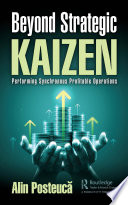

The book begins by tracing the roots of Kaizen, which is a Japanese term meaning 'continuous improvement.' It highlights how Kaizen has evolved from its origins in manufacturing to become a broader philosophy applicable across various sectors. The authors argue that while traditional Kaizen focuses on incremental changes, 'Beyond Strategic Kaizen' emphasizes the need for a more holistic approach that integrates strategic thinking with continuous improvement. This evolution is crucial as organizations face rapidly changing environments and must adapt to new challenges. The authors propose that by embracing a strategic mindset, organizations can not only improve processes but also innovate and create value in new ways.
Continue readingOne of the core arguments of the book is the necessity to integrate strategic planning with Kaizen practices. The authors present a framework that allows organizations to align their long-term strategic goals with daily operational improvements. They suggest that this integration can lead to a more agile organization that can respond to market changes effectively. The book provides practical tools and methodologies for leaders to implement this integration, emphasizing the importance of communication and collaboration across departments. This idea challenges traditional views of strategy as a separate function and positions it as an ongoing process that benefits from continuous improvement.
Continue readingThe authors argue that for Kaizen to be effective, a cultural transformation within the organization is necessary. They discuss the importance of fostering a culture that encourages experimentation, learning, and employee engagement. This cultural shift is essential for overcoming resistance to change and ensuring that all employees feel empowered to contribute to improvement initiatives. The book outlines strategies for leaders to cultivate such a culture, including the establishment of trust, open communication, and recognition of contributions. By transforming the organizational culture, companies can create a sustainable environment for continuous improvement.
Continue readingIn today's data-rich environment, the book emphasizes the importance of data-driven decision-making in the Kaizen process. The authors argue that organizations must leverage data analytics to identify areas for improvement, measure progress, and make informed decisions. They provide examples of how data can be used to track performance metrics and drive accountability within teams. The integration of data analytics into the Kaizen framework allows organizations to move beyond anecdotal evidence and make decisions based on objective insights, leading to more effective and efficient improvement efforts.
Continue readingBeyond just improving processes, the book discusses the role of Kaizen in promoting sustainability and social responsibility within organizations. The authors argue that continuous improvement should not only focus on operational efficiency but also consider the environmental and social impacts of business practices. They provide examples of companies that have successfully integrated sustainability into their Kaizen initiatives, demonstrating that it is possible to achieve economic success while also being socially responsible. This idea encourages organizations to rethink their objectives and consider the broader implications of their actions.
Continue readingThe book highlights the critical role of leadership in driving Kaizen initiatives. The authors assert that leaders must not only endorse continuous improvement but also actively participate in its implementation. They discuss various leadership styles that are conducive to fostering a Kaizen culture, including transformational and servant leadership. The book provides practical advice for leaders on how to inspire and motivate teams, create a vision for improvement, and lead by example. This emphasis on leadership underscores the idea that successful Kaizen efforts are not just about processes but also about people.
Continue readingFinally, the book explores future trends and challenges in the realm of continuous improvement. The authors discuss the impact of emerging technologies, such as artificial intelligence and automation, on Kaizen practices. They argue that organizations must adapt their continuous improvement strategies to leverage these technologies while also addressing potential disruptions. The book encourages readers to think critically about the future landscape of their industries and to remain agile in their approach to improvement. This forward-looking perspective is essential for organizations that wish to remain competitive in an ever-evolving marketplace.
Continue reading